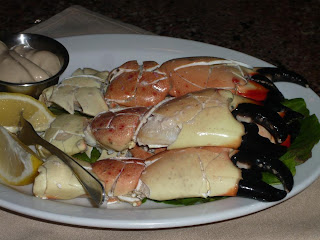
Stone Crabs are one of the real jewels from the gulf coast. Until I started traveling extensively, I didn’t give much thought to how lucky us Floridians were to have these delightful creatures in our backyard. If you enjoy seafood, you must love this crab too. Harvested from October to May, Stone crabs are fished in a unique way. They are caught in a standard crab trap whose buoys dot the shallow gulf waters. Only the claws (usually one) are removed and the animal is returned to the briny deep. There they will grow another in 12-18 months. This is quite a sustainable model. The claws are then cooked at the docks before being shipped to restaurants or fishmongers. Any delay in cooking would make the meat stick to the claw and very difficult to eat. This process makes for a consistent delicacy no matter where you eat them. For this reason, it would be difficult to write about the best place to eat Stone Crabs but there are a few tips I can offer so that you have the best possible experience.
There are 3 things to keep in mind when deciding to invest in a meal of Stone Crab. They are, after all, one of the most expensive pound for pound products the ocean has to offer. First, and most important, is freshness. Whether you are buying them from a fishmonger to eat at home or going to a restaurant, you should ask when they came out of the water. For me, a few days are max to get a great tasting fresh meat. Anything longer and the meat begins to take on that frozen taste. In my experience, though, it’s not difficult to find fresh Stone Crabs. Most places I‘ve been turn their product over very quickly so freshness isn’t usually an issue. I stay away from the grocery stores. Even if the guy behind the counter says they came in that day, he has no clue about the lag time from the water to his cooler. Too risky.
Then there’s size. This can be a bit tricky. They come in a few different size varieties from medium to jumbo. I’ve heard people say that a particular size produces a sweeter meat but I have not found this to be true. For this reason, I say get the biggest claw you can. The amount of work to get meat from a smaller claw is less worth it for me. Restaurants will always serve it with the claws already cracked. If you are taking the claws home from the seafood store, you’ll have to do this yourself. This video can help get into this thick shelled armor.
Lastly, I have to mention price. Cheaper is not always better but neither is most expensive. The above mentioned size and freshness play into the cost but so does abundance and demand. A season with heavy winter storms drives the price up as harvests are reduced. What I can buy for $12/lb one week can be $25/lb the next. You should be flexible if you can and not expect consistent prices.
If you are lucky enough to live on or visit the Gulf Coast anywhere from Texas to Key West, you can snatch up this amazingly sweet crab claw which is my all time favorite seafood. In restaurants it is usually served with some sort of remoulade, butter or Dijon sauce; all of which I adore. Cocktail sauce would be heresy, in my humble opinion. My favorite place in Tampa Bay is Frenchy’s Rockaway Grill on Clearwater Beach. They have their own fleet of fishing boats and the claws are always succulent and perfect. The rest of their menu is pretty awesome too, by the way. There supply has been limited at times, but otherwise they are some of the best. In the Miami area, I recommend Billy’s Stone Crab (that’s where I snapped this photo) on Hollywood Beach.

A bit too formal of a place to eat Stone Crab (I prefer the seaside shack environment), I still found their claws to be superbly fresh and the view of the mega yachts that travel the adjacent waterway is pretty cool. Probably the most famous place to eat Stone Crabs would be Joe’s Stone Crab on Miami Beach, but there you are truly paying for the name. Let the Euro-tourists drop their currency there. You don’t see too many locals.
I hope some of these tips help you with an amazing gastronomic experience.


No comments:
Post a Comment